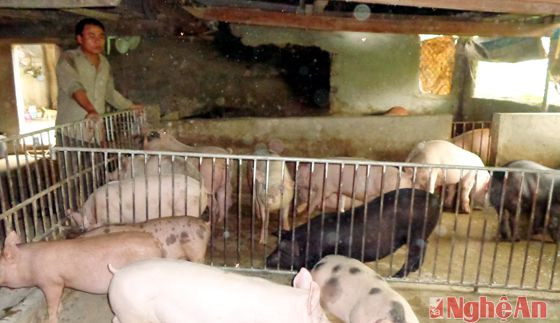Fermentation of microorganisms in livestock farming
(Baonghean) - Through the introduction of the leader of Thanh Ngoc commune (Thanh Chuong), we visited the family of Mr. Nguyen Huu Luong in Ngoc Dinh hamlet, one of the households applying the method of microbial fermentation to process animal feed.
Talking, Mr. Luong confided: Before knowing this new method, the family did not take full advantage of available agricultural by-products from corn and cassava plants to make feed for livestock. For example, during the corn harvest, only the cob and a few green leaves were taken for the buffalo and cows to eat, and the stems were cut down and dried for cooking. The same goes for cassava plants, only the tubers were taken, and the leaves were thrown away, so it was very wasteful. Now, with the microbial fermentation technique, the family collects all of them to process as a source of feed for livestock.
 |
| Mr. Nguyen Huu Luong's family uses fermented food to raise pigs. |
According to Mr. Luong, the technique of fermenting food with probiotics is also very simple and easy to do. First, from available ingredients such as corn, cassava... put them into a grinder to grind, mix the food mixture with an appropriate amount of probiotics. Then, put them in a barrel or sack with a tight plastic lining, and ferment in a dry, cool place. The fermentation time only needs to be until the food has a cool, fragrant smell and is slightly sour. The amount of fermented food should be used within 1-2 days, if left for too long the food will be too sour, affecting the quality.
As if to prove it, Mr. Luong happily led us down to visit his family's pig farm. The number is large, nearly 40 pigs, but one thing that is easy to see is that with fermented feed, the environment will be guaranteed to be clean and there will be less odor. Mr. Luong added that since using fermented feed, the pigs have grown and developed well, and gained weight quickly. On the other hand, the cost of feed has been reduced due to taking advantage of available, cheap local feed sources, and the amount of feed consumed will be significantly reduced due to increased food digestion and absorption. In addition, it also helps increase the resistance of livestock, reducing the rate of disease, especially intestinal diseases.
From that effectiveness, currently in Ngoc Dinh hamlet, there are many households raising pigs also applying this technique. Ms. Nguyen Thi Quyen - a resident in the hamlet shared: "Seeing Mr. Luong's family raising pigs with feed processed from microbial fermentation technique brings high economic value, and does not take much effort, so my family followed suit. Currently, the pig farm has about 60 pigs when supplemented with this feed, they grow very quickly, are healthy and the meat quality is guaranteed, easy to sell". People in Minh Nhuan, Ngoc Xuan, Ngoc Quang hamlets... also process feed from microorganisms to fatten buffalo, cows, and goats, bringing high economic efficiency.
Mr. Nguyen Cong Nong, Chairman of Thanh Ngoc Commune People's Committee, said: The project "Building a model of applying microbiological technology to process animal feed in Nghe An" was implemented by the Department of Science and Technology under a contract with Green Nghe An Company in the locality since December 2013. Up to now, the reality shows that this technique has proven its effectiveness, bringing many benefits to livestock farmers. From only a few households participating now in the commune, the number of families applying this technique has increased significantly. To continue to expand, people hope that the State will have a mechanism and policy to support part of the cost to help people buy raw material grinding machines and organize knowledge training to help livestock farming achieve higher efficiency...
Article and photos:Van Dang
